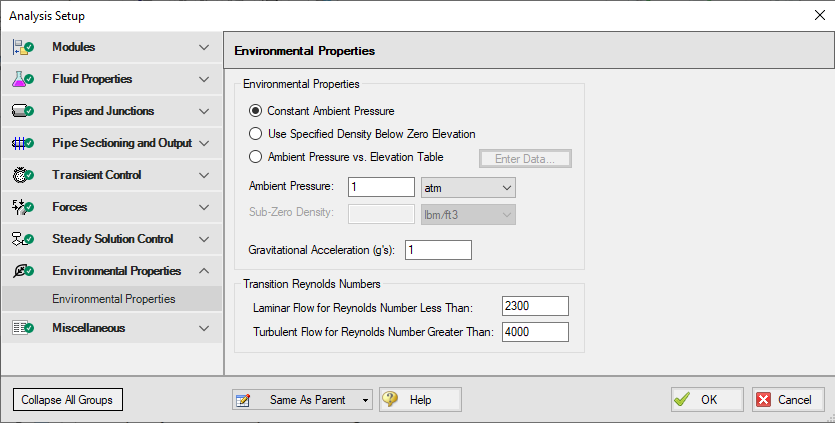Environmental Properties Panel
The Environmental Properties panel, shown in Figure 1, controls the definition of the atmospheric pressure, gravitational acceleration, and transition Reynolds number used to model the system.

Figure 1: Default state of the Environmental Properties Panel
Environmental Properties
Specify the ambient pressure and gravitational acceleration values for the solver to use in the calculations. By default, these values are 1 atm and 1 g, respectively.
Ambient Pressure
AFT Impulse uses a default atmospheric pressure of 1 standard earth atmosphere, or 14.696 psia. This pressure is also used to convert absolute pressures to gauge pressures. Keep in mind that atmospheric pressure varies with altitude. A project at Sea Level should not have the same atmospheric pressure as a project at 8500 feet. Impulse can adjust the atmospheric pressure automatically using the Ambient Pressure vs. Elevation Table option. Users can input a pressure profile to adjust ambient pressure depending on a junction's elevation.
Gravitational Acceleration
The default for gravitational acceleration is 1 standard earth gravitational acceleration, or 32.174 ft/s2. You can change this to a multiple of standard earth accelerations (that is, number of g's) according to the design environment for your system. In principle, the body force on a fluid system does not have to be due to gravity.
If the Variable g feature in the Waterhammer section of User Options is enabled, users are also able to add a transient to the gravitational acceleration. This could be used for systems in rockets or on a centrifuge.
Transition Reynolds Number
AFT Impulse allows you to modify the transition Reynolds numbers. The default values are Reynolds number less than 2300 is laminar and greater than 4000 is turbulent. In the transition zone a linear interpolation is assumed. This applies for friction factors.



